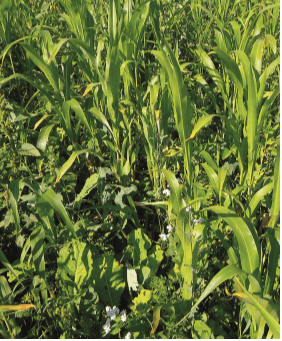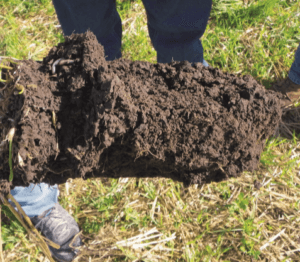The Importance of Planting Cover Crops

If you want to improve your soil, one of the most important things you can do is to plant cover crops. The benefit list is long including adding diversity to crop rotation, increasing organic matter, improving fertility, and erosion prevention. But they need to be selected with a purpose. What you are hoping to address by planting cover crops?
The following excerpt is from Dirt to Soil by Gabe Brown. It has been adapted for the web.
Planting cover crops is a key step in transforming dirt into soil.
We use cover crops on Brown’s Ranch and over the years we’ve learned a ton from our experience and from other farmers and ranchers working in regenerative agriculture.
Although I first started planting cover crops more than twenty years ago, I didn’t think of them as cover crops back then. I was just seeding crops to serve as livestock feed. Even now, I really don’t like to use the term cover crops. I prefer to call these crops biological primers because they do so much more than just cover the soil. For simplicity’s sake, though, I will refer to them as cover crops.
If you raise livestock and manage cropland, cover crops are an absolute no-brainer because livestock can help convert the covers to dollars quickly. If you do not have livestock, you should still plant cover crops for a host of reasons, including putting more carbon into the soil, feeding biology, protecting the soil from erosion, and, of course, improving profitability!
What Is Your Resource Concern?
People often ask me how I decide which cover crop species to seed in a mix. In order to answer that, I must first ask and answer the question, “What is my resource concern?” In other words, what am I trying to accomplish by planting this cover crop?
Do I want to improve the organic matter level of the field? Do I want to improve water in filtration? Do I need to increase species diversity? Improve nutrient cycling (i.e., reduce synthetic fertilizer use)? Control weeds? Manage pests? Address salinity issues? Provide wildlife habitat? Attract pollinators? Feed livestock? And the list goes on. The beauty of it is that cover cropping, practiced correctly, can address every one of your resource concerns.
I often hear producers say that they tried cover crops, but they did not work. In response, I ask them what their resource concern was. Usually that question draws a blank look from the producer. In other words, they seeded a cover crop without first thinking about what they wanted to achieve, which meant they had no logical basis for deciding what species to use. Often, they just seeded what was easily available. The result is usually not good.
 In terms of learning what types of cover crops may perform well in your area and deciding which ones will address your resource concerns, it’s important to do your homework.
In terms of learning what types of cover crops may perform well in your area and deciding which ones will address your resource concerns, it’s important to do your homework.
There is a wealth of information available online, including the book Managing Cover Crops Profitably, which is available for free download on the Sustainable Agriculture Research & Education website. The book includes descriptions of many common cover crops, where they can be grown, and their growth habits and benefits.
I also recommend that you seek out others in your area who are using cover crops and ask them about their experiences. Ask local seed suppliers for advice and attend local field days.
And I encourage producers to perform trials on their own operation every year. We try several different species and combinations every year on our ranch. If a species does well, I increase its use the following year. If it fails two years in a row, I do not try it again. It’s also important to understand the seasonality of the cover crops you are considering growing. For example, do not plant barley in North Dakota in July. Do not plant millet in North Dakota in April. I often think of this when I see many farmers in the northern plains planting corn in March and April. Last time I checked, corn was still a warm-season grass!
Let’s take a look at organic matter as a resource concern.
 Organic matter level is not the only key indicator in determining soil function; however, it is one of the foundations of a healthy soil. It is important to realize that organic matter levels fluctuate according to climate conditions and management. The definition of organic matter is matter that has come from recently living organisms. It is capable of decay, or a product of decay, or is composed of organic compounds. It is the flow of carbon energy through living organisms carrying out their metabolic processes, which create the organo-mineral complexes that entomb or coat the sand, silt, and clay particles.
Organic matter level is not the only key indicator in determining soil function; however, it is one of the foundations of a healthy soil. It is important to realize that organic matter levels fluctuate according to climate conditions and management. The definition of organic matter is matter that has come from recently living organisms. It is capable of decay, or a product of decay, or is composed of organic compounds. It is the flow of carbon energy through living organisms carrying out their metabolic processes, which create the organo-mineral complexes that entomb or coat the sand, silt, and clay particles.
I have never been on a farm or ranch, including my own, that is not degraded. If you search the archives where you live, you can get a good idea of what soil organic matter levels were a century or more ago. If the organic matter in your soils has dropped as much as they have in my area (from over 7 percent to around 2 percent), you do not have properly functioning nutrient or water cycles on your land.
Farms with low soil organic matter must rely on synthetic inputs to do the jobs that nature originally did for free. As organic matter levels rise, and we provide a habitat for soil biology, the amount of available nutrients in the soil increases dramatically. I did some calculations, and at the time of writing, for every 1 percent increase in organic matter, there is the equivalent of about $750 per acre’s worth of nitrogen, phosphorus, potassium, and sulfur inputs. Realize that you must first have the biology to cycle these nutrients. Management is key to achieving that, and when you do have the levels needed, you will be able to significantly cut inputs, thus improving profitability.
Approximately two-thirds of the soil organic matter increase will come from establishing roots in your soil. It’s critical to put as much root mass as possible into the soil, from the surface all the way down into the subsoil. These roots pump the liquid carbon to feed the biology that is critical to soil function.
Cover crops such as sorghum/sudangrass, cereal rye, annual ryegrass, phacelia, and red clover, among others, will produce large amounts of root mass to achieve this. One cover crop blend I like to use is a warm-season blend of sorghum/sudangrass, pearl millet, cowpeas, mung beans, annual sweetclover, sunflowers, kale, daikon radish, buckwheat, and safflower. This mix gives us a good variety of different root types and rooting depths to fill the soil profile, thus increasing organic matter. The different leaf shapes maximize solar energy collection, and the variety of flowering species attracts beneficial insects.
Keep in mind, though, that while these species work on our operation they may not work on yours. You will never know unless you try!
Recommended Reads
Recent Articles
You know of Dasher, Dancer, Prancer & Vixen. Comet, Cupid, Donner & Blitzen. Rudolph too! But have you heard of the Sámi people who herd reindeer in Norway?
Read MoreNo heated greenhouse? No problem! Discover the secrets to thriving winter gardening without breaking the bank.
Read MoreWintergreen is the stunning evergreen groundcover that’s a game-changer for your garden! It’s cherished for its aromatic leaves, vibrant fall color & bright berries.
Read MoreYear-round growth without the hefty price tag of a greenhouse? Low tunnels are the cost-effective and flexible solution you’ve been looking for. Grow year-round with low tunnels!
Read More

 In terms of learning what types of cover crops may perform well in your area and deciding which ones will address your resource concerns, it’s important to do your homework.
In terms of learning what types of cover crops may perform well in your area and deciding which ones will address your resource concerns, it’s important to do your homework.







